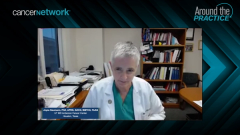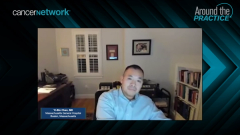
Acute GVHD: Staging and Grading Criteria
A discussion on staging and grading criteria used in the assessment of acute graft-vs-host disease, and the potential role of biomarkers moving forward.
Episodes in this series

Parameswaran Hari, MD, MRCP: Let’s go into the second part of our discussion. We have a section on acute graft-vs-host disease [GVHD] that we’re getting into now. Nelson, from a center perspective, you already said that most of your transplants are matched donors and a combination of myeloablative and reduced intensity with CNI [calcineurin inhibitor] methotrexate prophylaxis and then haplos (haploidentical) with post-(transplant) cy(clophosphamide). What would you say is the incidence of (grade 2 and above) acute graft-vs-host disease?
Nelson J. Chao, MD, MBA: Overall, taking all comers, it’s probably around 40%.
Parameswaran Hari, MD, MRCP: That’s something that I would say, too. And if you think of that 40%, what percentage would end up being steroid refractory where we’re worried about their outcome and GVHD becomes the prime determinant of their mortality?
Nelson J. Chao, MD, MBA: Probably about half of those. Of all the people who show up, about half will respond and half won’t.
Parameswaran Hari, MD, MRCP: Broadly, I would also agree with that. Yi-Bin is also nodding. I’m going to say about a quarter of patients—somewhere between 20% to 25%—depending on the patient’s age, donor age, and all other factors taken into consideration. There are so many variables that we didn’t talk about in the risk for GVHD but would end up with severe acute graft-vs-host disease that leads to prolonged hospitalization and an agent beyond the primary agent, which is steroids. These days, even at our center, the first line that I give is the steroids, the second line is ruxolitinib, and then you go into the territory where there’s relatively unchartered territory. Would you say that’s consistent with what you do, too?
Nelson J. Chao, MD, MBA: Absolutely.
Parameswaran Hari, MD, MRCP: Thanks. Let’s go to the grading effect of acute graft-vs-host disease. Yi-Bin, the grading effect of acute graft-vs-host disease is also in evolution. I would like you to give us a bit of idea of how the grading has changed over time and the role of plasma biomarkers in acute graft-vs-host disease.
Yi-Bin Chen, MD: The grading of acute GVHD hasn’t changed all that much. As Joyce mentioned when she was talking about the symptoms, if someone has cutaneous involvement, we’re basically measuring the body surface area as a surrogate for extent. When they have lower GI [gastrointestinal] disease and diarrhea, unfortunately for everyone involved, we’re measuring the volume of diarrhea on a 24-hour basis, which is horribly inaccurate for a lot of reasons due to its influence by what patients take in orally and what medicines we're using, (including) antibiotics and so forth. Trying to estimate it when patients are in outpatient care is almost impossible.
With hepatic acute graft-vs-host disease, we look at the elevation of the total bilirubin level. It's undergone some revision. In 2018, the MAGIC [Mount Sinai Acute GVHD International Consortium] Consortium, which we're a part of, published consensus guidelines that many of us have started to use, which tried to refine how we stage acute graft-vs-host disease and took the factors that I just described and tried to solve some of the gray areas. As outpatients, you try and factor in not only the volume, but also the number of bowel movements and so forth. When you look at a rash, what happens if it's spotty and patchy and not confluent? That document has served as a consensus guideline for how we stage acute graft-vs-host disease and is used by a lot of clinical trials. But in general, we gave all those 3 organs an individual stage, and that makes up an overall grade, which is then shown to be prognostic. That helps us communicate clinically and also in clinical trials.
You brought up the role of plasma biomarkers. The MAGIC Consortium certainly has had a huge effect in publishing a lot of work suggesting that measuring 2 plasma biomarkers, specifically ST2 and REG3-alpha, can help in the assessment and evaluation of acute graft-vs-host disease. These are commercially available tests where you can send these plasma biomarkers out and get a prognostic score called the MAP [MAGIC algorithm probability]. I'm going to emphasize that these biomarkers aren’t diagnostic biomarkers by any stretch. They’re merely measures of inflammation and organ injury, and specifically injury to the GI mucosa, and that’s thought to give a biological signal of how aggressive one's acute graft-vs-host disease is.
From all of the analyses that we have, we know that measuring MAGIC biomarkers 1 week after transplant can prognosticate patients to different risk groups for developing acute graft-vs-host disease. We know measuring those biomarkers at diagnosis can risk-stratify patients into different risks for non-relapse mortality. We know measuring biomarkers a week after treatment and 4 weeks after treatment can help prognosticate patients and probably can help better judge response to current therapy. There never has been a trial, though, that has really defined that you should change your treatment based on the measurement of those biomarkers. We have not proven that, though a lot of our colleagues are using the biomarkers to do just that. I'm just not sure that's proven yet. We are actively doing clinical trials to try to prove that.
One of the most popular approaches these days is for patients who were just diagnosed with new acute graft-vs-host disease. We can send biomarkers, you can get a score, and those who are high-risk by the biomarkers, you might want to give steroids plus another drug to augment their chance of response. For those who are low risk, you might want to avoid steroids altogether, as we did in a recent CTN [Clinical Trials Network] trial 1501, using sirolimus. Or you start steroids and have a fast taper to get patients off steroids as fast as possible. These are the ways, moving forward, that biomarkers will help hopefully make progress in acute graft-vs-host disease.
Transcript edited for clarity.
Newsletter
Stay up to date on recent advances in the multidisciplinary approach to cancer.






















































































